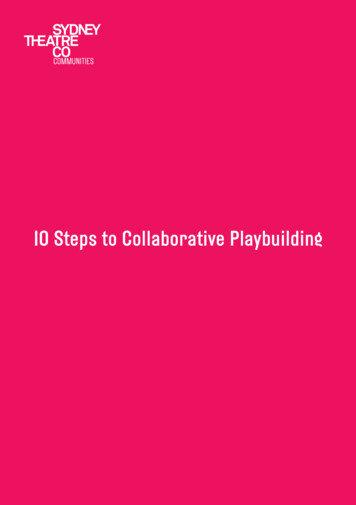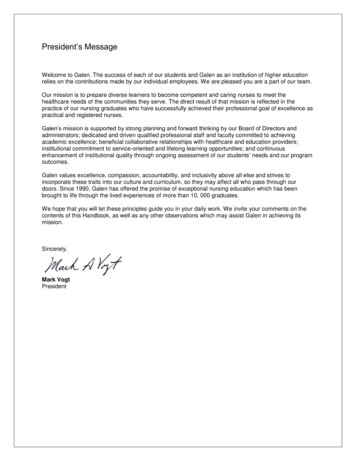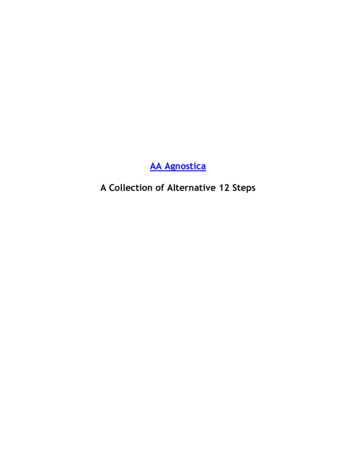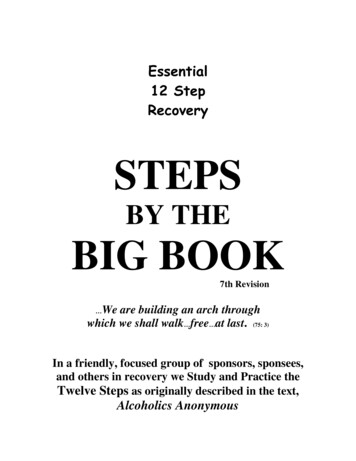
Transcription
10 Steps to Collaborative Playbuilding1
Compiled by Hannah Brown.This resource is designed for educators as the starting point fordeveloping more comprehensive lessons for this play. Hannah Brownis the Education Projects Officer for Sydney Theatre Company. Youcan contact Hannah on hbrown@sydneytheatre.com.auCopyright protects this Education Resource. Except for purposespermitted by the Copyright Act, reproduction by whatever meansis prohibited. However, limited photocopying by educationalinstitutions for classroom use only is permitted.2
10 Steps to Collaborative PlaybuildingThe purpose of this guide is for teachers and students alike to beable to follow the steps in order to create a play from scratch. It isimportant to note that this way of playbuilding is collaborative,where all students take on the roles of actors and directors andnegotiate the creation of the piece. Throughout this process theteacher is to act as a facilitator.Playbuilding and CollaborationPlaybuilding is the process of building an ensemble piecethat is created by students from the needs or interests of thegroup. Playbuilding is a method of collaboratively creating aperformance. Sometimes the process of creating the play is justas important as the product – the performance. This is becausethe skills gained by the ensemble members during the creatingprocess are invaluable life skills: working in a group, givingand accepting constructive criticism, taking on a position ofresponsibility, building confidence, finishing a product andexperiencing walking in someone else’s shoes.The process can also serve as a cathartic experience for anensemble which is looking for rehabilitation or to manage acertain experience or event.Production ScheduleAs a class or within the devising group, it is a good idea to createa production schedule with checkpoints to work towards anddesignate someone to monitor this. Such checkpoints could3
include when to have certain scenes finished, when to do workin-progress showings and when to have lines down. To create anexact production schedule, mark down the performance date andwork backwards.Rehearsal WorkbookStudents should each keep a rehearsal workbook where ideas,scripts and research can be documented. During or after eachrehearsal, students can dot point what was achieved so that theycan pick up where they left off in the next rehearsal.4
STEP ONECreating an EnsembleAn ensemble that works together and listens to one another bothon and off the stage is essential in playbuilding. A play ensembleis different to working in groups in class as the process is longerand more intense, so the need to create a sense of cohesion,knowledge about one another and awareness of each other’sabilities is important. Ensemble skills can be gained throughgroup drama games and trust exercises.Examples of such exercises include:Knife and ForkStudents walk in the space. The teacher calls out a number andan object. Students form groups of that number and createthe object with their bodies. Repeat this process with differentgroups and different objects. For example, “groups of five” and“create a bicycle”.Human MapThe teacher designates the different points in the classroom whichrepresent the North Pole, South Pole, East and West. The teacherasks students to go and stand on the map in different places. Forexample, “your favourite holiday destination,” or “where youwere born,” or “the most boring place on earth.” The teacher thengoes around the room and asks students where they are and why.Repeat as many times as desired.Circle of KnotsThe group stands in a tight circle. They all join hands with one5
another across the circle, sideways, over the top of one another.They must then untangle themselves without letting go of theirhands. For an extra challenge this activity can be done in silence.Blind CarPairs. One person has their eyes closed and is the car, the otherperson is the driver and stands behind them. The driver uses handsignals on the back of the person who is the car to ‘drive’ themaround the room. The hand signals are: to go forward (pressingon their back), backwards (tapping on their back), stop (one tap),left (tap left shoulder) and right (tap right shoulder). This gameis about trust so the car must keep their eyes closed and trust thatthe driver won’t allow them to bump in to anything.Sonic ShowerPairs. This game is to be played with care and is to be donewalking, not running. Person A has their eyes closed. Person Bchooses a sound and demonstrates it to their partner. Person Amust follow the sound of Person B as they move around the room.The In a Heart Beat process:“Genuine community engagement was at the core of the project, withan extensive consultation period. STC’s Education Manager and theDirector travelled to Armidale to establish relationships and build anatmosphere of trust and excitement. The first week of the project thisyear was focused on in-school workshops, followed by consultationswith community leaders, and an open after school workshop programin youth-friendly public venues in the afternoon.”6
STEP TWOA Way InPrior to beginning the process, it is best to have a broad ideaabout a theme, concept or issue that will be explored. This canbe initiated by the teacher or students and broadly investigatedthrough research and exercises such as a ‘Walk Through Museum’or ‘Gallery Wall’ in the classroom or ‘Shared Stories.’Walk Through MuseumScatter pictures, poems, objects, songs, newspaper articlesand excerpts from plays about the topic around the classroom.Leave room for students to walk amongst the stimulus and stopand read. Choose a piece of evocative music to play as studentsexplore the museum. From this ‘Walk Through Museum’ thecentral question or statement can be created.Gallery WallCreate a designated wall space in the classroom and pin uppictures, poems, objects, songs, newspaper articles and excerptsof plays about the topic. This wall can be added to as the devisingprocess continues, creating a documentation wall. Choose a pieceof emotive music to play as students peruse the gallery wall.From the ‘Gallery Wall’ the central question or statement can becreated.Shared StoriesAsk students to find a space in the classroom and lie down withtheir eyes closed. Ask students to think about a particular momentin their life as chosen by the teacher. This could be when they feltalone, scared or regretted a decision. Ask students to recall allthe exact details – what they saw, what they heard, what they felt,7
what was said and who they were with. Allow students time toreally investigate these memories and play some evocative musicto create a solemn and serious atmosphere in the classroom.Divide students up into groups of five and ask them to each sharetheir story. Students choose one story from each group that is thenshared with the class. The class then chooses the most movingstory which then acts as the stimulus for the central question orstatement of intent explored in the play. The shared stories canbe documented using the worksheet at the back of this booklet.The In a Heart Beat process:“Participant surveys were a major part of the communityengagement process, where project participants provided informationon their perceptions of Armidale and hopes for the project. STC alsocrowd-sourced artistic content, most obviously in the development ofthe play itself, but also through a call out for local artists to submit animage of Armidale to feature as the ‘hero image’ on all promotionalmaterials such as posters and brochures.”8
STEP THREECentral Question or Statementof IntentWhen trying to think of a question or statement, think aboutwhat the audience could feel, think and know at the end of aperformance.The central question or statement of intent is the specific idea theplay is devised around. It is important that the central questionor statement is specific. Statements like “Being a teenager ishard” are too broad and do not conjure enough imagination orstimulus for creating scenes. Questions and statements need tobe contextualized and evocative, for example, “At 16 you don’tneed sickness or death for tragedy.” This statement immediatelyconjures thoughts about the problems experienced by ateenager and how these problems compare to those in the widercommunity and the world. Links could also be made to classicaltragedy texts such as the work of Shakespeare.The In a Heart Beat process:“The brief for the project was to strenuously avoid an ‘issues basedplay’ that looked at a pre-determined topic such as teen pregnancyor peer pressure. Instead, the content that came from the workshopswith young people was resolutely everyday, resulting in In a HeartBeat being a play about perspective - if things are too foreign, we feeldiscombobulated, if things are too familiar, we feel stifled.”9
STEP FOURStoryboard and Characters4.1 BrainstormBefore creating a storyboard, use a lesson to brainstorm on thewhiteboard all thoughts, ideas, characters, places, objects etc.relating to the statement of intent or central question. Studentscan document this brainstorm in their workbooks.4.2 StoryboardOnce the brainstorm is complete, draw ten boxes on the board,each box represents a scene. As a class work together to decideon what will happen in each scene and which characters will bepresent. If the class is big, it is a good idea to break the class inhalf and have one group perform the first half of the play and theother group perform the second half. Characters can be signifiedusing costume so the audience is not confused by the change.Once the storyboard has been created, think about playing withthe story by considering:Narrative structureNarrative structure impacts on the audience’s engagement withthe play and the viewpoint from which the story is told.Linear Narrative – The story is told sequentially, from beginningto end. There is a problem which is established, reaches its climaxand is then resolved.Non-Linear Narrative – Events are depicted out of chronologicalorder. It is often used when the play is a memory and the differentmemories come together at the end to portray an event or feeling.10
Cyclical Narrative – The story begins at the end and then worksbackwards to portray how the end came about. The story thenends with the same scene that opened the play.Episodic Narrative – Each scene stands alone and acts as anepisode. They can feature different characters in different timesand places. Each episode is linked by a similar theme or event.ViewpointFrom whose eyes is the story told? Is there one central characterthat the story follows or are there several characters that the storyjumps between?StyleWhat style/styles will be utilised in the play? Think about howstyle can complement the narrative and strengthen the meaningfor the audience. Consider Realism, Contemporary Realism,Physical Theatre, Ritual, Magical Realism, Absurdism, PoliticalTheatre, Shadow Work, Comedy (Parody or Farce), CollageDrama and Documentary.ConventionsConsider how different conventions can be incorporated andstrengthen the statement of intent for the audience. Suchconventions include: direct address, narration, audienceinteraction, chorus, repetition, multiple role, fast forward/rewind, slow motion.SymbolIncorporating symbol strengthens Dramatic M eaning as theyare representations of the statement of intent or central question.Symbols can be objects, movements, songs, media backdrops, set,props and costumes.11
4.3 TechniquesBrainstorm some initial ideas about staging, lighting, sound/music and media. How can these techniques complement theworld of the play, enhance the style and strengthen the meaning?The In a Heart Beat process:“We brainstormed the themes of home, isolation, leaving andreturning, bullying, social media, dating from a number of differentangles - either through verbal improvisation, writing scripts, physicalresponses, using music and choreography. All of the participantsprovided a favourite song which we used at different points duringthe week.”12
STEP FIVEDevise and Rehearse5.1 Outer world of the playBefore beginning the devising process look at the storyboard andconduct any research that may need to be undertaken to informthe content of scenes. Research and document the findings in thedevising scrapbook.Consider: Where is the play set? What historical era is the play set in? What are the social and political conditions? Is there anything special about the characters that needs to beinvestigated such as medical issues or cultural background?5.2 Begin the devising processBegin the devising process by standing up and improvising thescenes. It is a good idea to start each scene with a freeze frameand corresponding caption that encapsulates what the scene isabout. This gives the devising process some direction. Aim foreach scene to be between three and four minutes in length.5.3 Inner world of the playThe inner world of the play refers to the dramatic action andcharacters of the play. Once scenes have been devised, studentsshould sit down with their workbooks and analyse anddeconstruct the inner world of the play and their character. Thiswill allow for them to have greater investment in the play andportray their characters truthfully. This can be documented inthe workbook.13
Consider: What is the character’s objective in the different scenes? What is the character’s super-objective for the entire play? What is the character’s motivation in the scene? Are there any obstacles that are in the way of the charactergetting what they want? What voice and movement choices have been made in creatingthe characters? Can these be improved? What choices have been made in language that portrays thecharacter and their motivation? How does movement in the space portray character motivation,relationships and tension?Once scenes have been devised, think about different ways toobtain feedback and improve the scenes. Consider the following:5.4 Director outside the actionAllocate one student who will watch the scene from beginningto end and stop the scene to fix and improve the dramatic action.The student in the role of director can take notes and should payparticular attention to characterisation (voice and movement),language, dialogue and transitions. Ultimately, they are lookingto ensure that meaning and the story are clearly communicatedand that the scene links directly to the statement of intent orquestion.5.5 Work in progress showingDesignate a date in class where groups show one or more ofthe scenes they have been working on. The class is then invitedto give constructive criticism and outline what they liked, whatthey think worked and what can be improved on. The devisingprocess is collaborative and not competitive. It is not about whosescenes are better, but about the ensemble working together to14
communicate the statement of intent or central question. It isbest for students to be ‘active viewers’ and have elements they arelooking to critique in the scenes. This could be characterisationor Elements of Drama such as mood, tension or place.The In a Heart Beat process:“During an intense devising period a small number of young peopleworkshopped ideas to feed into the eventual script, with this grouplater invited to STC to provide feedback on the script following a twoweek creative development period with professional actors.”15
STEP SIXDesign DecisionsOnce the scenes have been devised, begin to incorporatemusic, props or essential pieces of costume that will be usedin the scenes. Decide on the set and backdrop for the play anddesignate a member of the ensemble to create or source thesedesign elements. Media could be used for a backdrop and helpin the creation of place. Document the design decisions in theworkbook.It is best to keep design elements to a minimum. The focus shouldbe on the creation of scenes and characters through the body inthe space.The In a Heart Beat process:“It as a challenge to bring the world of In a Heart Beat to life onstage. As scenes were written and rewritten, so were design sketchesand ideas. We have 14 different settings and 24 characters to realise.The brief - be simple, imaginative, and use what we already have asmuch as possible. Renee and I have a shared love of anything oldand theatrical, and since the action of the play now takes place inthe lead up to the Armidale show, a carnivalesque quality runsthrough the design.”16
STEP SEVENWrite the ScriptOnce the scenes have been created, it is time to write the script.Writing the script is best done at this point in the devisingprocess, as if attempted earlier it can hinder the creative processand cause the ensemble to focus only on the words and not thedramatic action. What evolves out of the improvised devisingprocess is always more fruitful, natural and seamless than firstwriting a script.Writing the script can be done by the ensemble performing theplay while one person sits out and types the script on a laptopor writes the script by hand, halting the action if time is neededto catch up. The script can also be written by videoing theperformance and typing up the play while re-watching it.The script can then be compiled and distributed to the ensemble.The script ultimately serves as documentation and a reference forthe actors who by now should know their lines and cues.The In a Heart Beat process:“The director and writer workshopped the script in process at theWharf for two weeks with professional actors Danielle McCormack,Alan Flower and Amber McMahon. At the end of the fortnight, fourstudents from the devising week and four Armidale teachers travelledto STC to provide feedback on the script. 71.4% described the playreading as ‘Highly Valuable in stimulating discussion about themesand issues relevant to Armidale’.”17
STEP EIGHTPolishPolishing the scenes involves tightening the dramatic actionand occasionally tweaking and editing the dialogue to ensurethe scenes are sleek and link directly to the statement of intentor question. The transitions from scene to scene should be shortand sharp to ensure the dramatic tension is sustained, the moodis intensified and the rhythm of the piece flows.8.1 Dress and technical rehearsalsDuring the polishing process technical rehearsals and dressrehearsals should take place. The dates for the dress and technicalrehearsals should be designated in the production schedule.8.2 Recording a runIt is a good idea to video a full run-through and watch it backas an ensemble. When watching, students can make notes onelements needing improvement. Students can then go back andpolish anything that needs noticeable development.The In a Heart Beat process:“The play was pulled apart, put back together, thrown out withthe bath water, resuscitated, reformed, renewed and reinvigoratedover an intense period of time. Notes were taken and the play wasredrafted six times. Characters were cut, new characters appeared,imaginary underworlds were mapped, and a talking kangarooturned into a talking goat.”18
STEP NINEPresentThe play is now ready to perform to an audience! Take a momentbefore going on stage to obtain focus and ensure all the hardwork pays off!The In a Heart Beat process:“Opening night was a triumph. After the show finished, peoplestayed sitting in their seats, talking about the story they had justseen, the characters, the relationships. There was a sense thatthe community really saw themselves reflected in the play. Theycompletely related to Jamie’s story, the bullying he went through, andAnnabel’s story of trying to deal with a troubled teenager, and theguilt she felt about trying unsuccessfully to keep it all together.”19
STEP TENReflectReflecting on creating the play is essential as it reinforces thelearning undertaken in the collaborative process. The reflectioncan be undertaken in many different forms such as groupdiscussion, pair discussion or written journal reflection. Beloware some questions to consider: What worked well in the devising process? What did not work well in the devising process? What discoveries did you make about yourself? What did the ensemble do together particularly well? What discoveries did you make about working with others? What new skills have you obtained? What would you do differently in the process next time? What was hard about the process? What was easy? What moments in the piece were particularly movingor strong and why? What characters were strong and why? Which characters could have been improved and how? How do you think the audience was impacted by the piece? Was the statement of intention or central question clear?How could it have been clearer?The In a Heart Beat process:“One of the most rewarding parts of this process was watching howall of the cast and crew from Armidale really lifted and grew. Giventhe opportunity to contribute to the solutions, but also asked to workto high professional standards, they all developed and rose to thatchallenge in a really wonderful way.”20
A Way In - Shared StoriesYou need to be prepared to share this story with your group, yourclass and even the wider community if your story is selected asthe stimulus for the collaborative process.Think of a significant moment in your life. When you felt scared/alone/sad/disappointed When you were devastated by news When you achieved somethingRead through the table first and then fill out each section.Title of storyOutline of story(one or two sentences)Setting of the storyDetails of the storyWhat happenedchronologically(this can be dot points)21
What were you feelingat the time? in the build up to theevent at the climax of the event after the eventHow did you seeyourself? (perception) before the event after the eventWhat were you thinking?What do you rememberseeing?What do you rememberhearing?What do you recall sayingto anyone?Who do you rememberbeing there?22
BibliographyBoal, A. (2002). Games for Actors and Non-Actors.New York: RoutledgeClausen, M. (2006) Centre Stage. Creating, Performing andInterpreting Drama. Melbourne: HeinemannTaurelle, T., & McNamara, M. (1998). Performance – A PracticalApproach to Drama. Melbourne: Heinemann23
Knife and Fork Students walk in the space. The teacher calls out a number and an object. Students form groups of that number and create the object with their bodies. Repeat this process with differen










